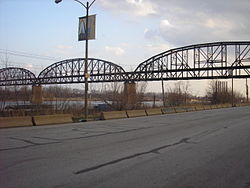I'd been wondering what the plan was on those; I knew about the "add two cars" decision (as we've discussed before, capacity is a major limiting factor on the Acela). Of course, I honestly don't quite see room for three levels of service on the current alignment...running anything under 110-125 doesn't make sense, you've got the current cap of 150-160...and there's nowhere to stick in 200 MPH trains without an absurdly expensive new alignment, which IMHO would be a waste of money at this stage unless you're also going to somehow rope in additional markets. That said, if the "top" brand fights on quality of service as well as speed (and again, unless you start cutting stops you're really at a point of diminishing returns without new alignments, and I can't really see the justification without adding something significant to the rider base)...do we start calling those cars the "Merchants Fleet"?
Back to the Acela-I fleet: The speculation I'd heard, of shifting them into Regional service, suggests that what might instead happen is a marginal upgrade for the Acela-II service and a marginal downgrade for the Acela-I service. Ironically, I think offering guaranteed connections to trains outbound from WAS and NYP with the "downgraded" service might make them attractive to a lot of folks...but again, having two high-level services that aren't terribly different from one another risks cannibalization of the market.
I don't think Amtrak would create a split between the current Acela and new Acela II service. The Amtrak Fleet Strategy plan calls for the current Acelas to be retired by 2023 by which time they will be over 20 years old and have a lot of miles on them. The Acela IIs are not expected to start delivery until 2017 and that is an optimistic schedule. Even if the new Acela IIs can run at 220 mph, I seriously doubt even the proposed first 220 mph section in NJ would be in service before the current Acelas are retired. No, Amtrak will stick with a 2 tier system because it works - the 125 mph Northeast Regionals, Keystones, and corridor & LD trains that operate beyond the NEC and the premium Acela NEC service.
Personally, I am in the camp of rather see the funding spent over the next 8-10 years to bring the current NEC up to a state of good repair with 150-160 mph speeds over more segments, replace the old tunnels and bridges, 2 new tunnels under the Hudson, track & catenary upgrades from NYP to WAS in section by section, expand capacity with 3rd and 4th tracks, fix the slow bottlenecks and curves, and get serious about ROW re-alignments in selected segments in eastern CT. Achieve a goal of 2:15 (or less) Acela trip time from WAS-NYP and do what it takes to achieve 2:45 Acela BOS-NYP. The costs in the Northeast of building the 220 mph sections has the potential to drain the available funding from other HSR and improved passenger rail projects outside of the NEC. Get the current NEC in much better condition, then if the support is still there, get started on building the selected 220 mph sections.





